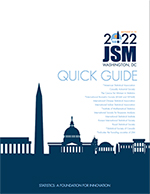Back
2022 Joint Statistical Meetings
Survey Research Methods Section
Session: Trends in Sample Design
Forming Area Sampling Units with Geospatial Sorts, with Application to the Program for the International Assessment of Adult Competencies (PIAAC)
Thursday, August 11, 2022
Activity Number: 526
-
Benjamin Schneider
Westat
Multi-stage area sample designs are often employed to reduce the cost of in-person surveys, where sampling units are formed by combining geographic areas such as counties or Census blocks. Sampling error is reduced by forming sampling units with low between-unit variance in outcomes of interest, and costs are typically reduced by forming sampling units which are compact, complete, and based on contiguous geographic units. Kali et al. (2021) presented an algorithm for grouping Census blocks into sampling units in a way that balances these factors. Census units are geospatially sorted using space-filling curves, and then sampling units are formed by adding Census units to a sampling unit until the sampling unit attains a minimum measure of size. The space-filling curves promote compactness but often yield split sampling units, which increases data collection costs. To reduce splits, in this paper we introduce graph-based geospatial sorts based on Census units’ adjacency relationships. We evaluate the geospatial sorts’ performance in forming primary and secondary sampling units based on counties and Census blocks for the Program for the International Assessment of Adult Competencies.

